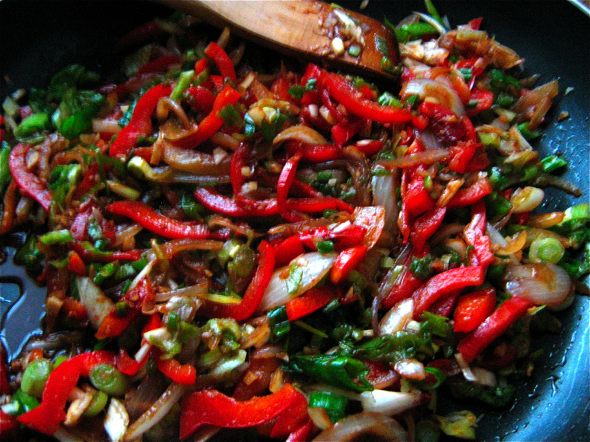I guess I forgot to write this one up. It’s such an easy recipe that I overlooked it. To the recipe (and anyone who wanted it, I suppose), I apologize.
The only thing I changed from a traditional japchae recipe was the use of seaweed instead of spinach (oh, and I guess the ginger isn’t really traditional either). It was an issue of practicality since I had seaweed and didn’t have spinach, and there was absolutely no way I was going for a 20 minute walk in the -25 degree Celcius heat to get a bag of spinach when seaweed would be just fine. What I ended up doing was soaking the seaweed in hot water until tender (about 15 minutes) and then using that soaking liquid combined with the dried mushroom soaking liquid to then soak the yam starch noodles! It was essentially a home-made dashi broth (Japanese term not Korean term, I know. Again, forgive me recipe et al) that added a lot of flavour to otherwise bland noodles. Well, subtle flavour. In restaurant reviewing “subtle” = “bland”, but I decided I could live with that.
Ingredients:
1 package, or one large handful of a very large package of Korean Yam Noodles (about 1/2 lb). You’ll end up with lots. Or use any other cellophane noodles that are gluten-free. Sometimes you’ll see beanstarch (or thread?) noodles, I think, but traditionally Korean noodles are sweet potato, yam, or bean thread for this recipe. It could also be a lost in translation kind of thing. Who knows?
2 tsp vegetable oil (or peanut for more flavour. Not sesame, though, since the flavour will just fade by the end)
1 onion, thinly sliced
2 carrots, sliced like the onions (optional)
2 cloves garlic, diced or minced
2 tsp fresh gingerroot, diced
1 red, orange, or yellow pepper, thinly sliced
1/2 package of dried mushrooms (shiitake, wood ear, whatever you want), soaked until soft in hot water and then chopped to match the other vegetables if need be.
1/2 lb spinach, washed well and drained (spinach here is traditional, but I didn’t have any, so I used a large handful of dried seaweed instead, torn into short, spinach-like pieces. See above)
3 green onions, thinly sliced (all of the white part. Chop a little of the green part for garnish at the end)
2 tbsp soy sauce or tamari
2 tsp sugar
1/2 tsp red pepper flakes or 1/4 tsp red pepper hot sauce (optional, but encouraged)
1 tbsp sesame oil, divided
2 tsp sesame seeds, toasted (in a dry frying pan for a few minutes on medium heat until lightly browned and aromatic)
Instructions: Soak all the dried things: Fill a large pot with about 7 cups of water and bring to a boil. When water is boiling, add the seaweed (if using) and mushroom. Turn off heat. Let stand until soft. The seaweed takes less time than the mushrooms, so do this step in advance. It doesn’t matter if they “over-soften”. That’s impossible. Just don’t boil them. Let them soak. Be patient.
While things are soaking, toast the sesame seeds.
Drain the soaking liquid into another pot (or just remove the mushrooms and seaweed with a slotted spoon and bring the liquid back to a boil. Let the seaweed and mushrooms drain a little. When the liquid boils add the noodles. Turn off the heat and let stand until tender (about 15??). Then drain, reserving the liquid just in case you need to re-soak later. Use scissors (or kitchen shears, but who has those?) to cut noodles into shorter pieces, about 8 inches in length. Set aside.
Toss the mushrooms and seaweed with 1 tsp of the sesame oil in a large bowl. Set aside. Geez this requires counter space…
In a small bowl, mix together the soy sauce, sugar, and red pepper flakes (or hot sauce).
 Heat the vegetable oil in a large frying pan or wok on high heat and swirl to coat. When the cooking oil is hot but not smoking, fry the garlic and ginger. for about 1 minute. Add the onions, peppers and carrots, until just softened, about 1 minute. Add the green onions (reserving the green parts for garnish), mushrooms and seaweed (or spinach). Fry 30 seconds.
Heat the vegetable oil in a large frying pan or wok on high heat and swirl to coat. When the cooking oil is hot but not smoking, fry the garlic and ginger. for about 1 minute. Add the onions, peppers and carrots, until just softened, about 1 minute. Add the green onions (reserving the green parts for garnish), mushrooms and seaweed (or spinach). Fry 30 seconds. 
Then add the soy sauce, sugar and noodles. Fry 2-3 minutes until the noodles are cooked through. Turn off heat, toss with the toasted sesame seeds and the remaining 2 tsp of sesame oil.
Stir. Eat.
Leave a Reply